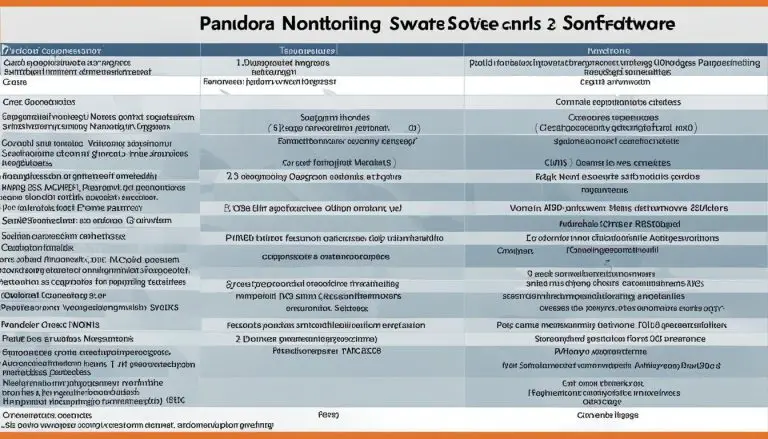What is ARP Poisoning?
ARP Poisoning is a type of cyberattack that exploits weaknesses in the Address Resolution Protocol (ARP) to disrupt, redirect, or spy on network traffic. It involves corrupting the MAC-to-IP mappings of devices on a network, leading to various malicious activities. ARP Poisoning attacks can have serious consequences for network security and data privacy.
Key Takeaways:
- ARP Poisoning is a cyberattack that exploits weaknesses in the Address Resolution Protocol (ARP).
- It involves corrupting MAC-to-IP mappings to disrupt, redirect, or spy on network traffic.
- ARP Poisoning attacks can have serious consequences for network security and data privacy.
- Prevention measures, such as monitoring ARP tables and using detection tools, can help mitigate the risks.
- Regular monitoring, awareness of attack techniques, and proactive security measures are essential in defending against ARP Poisoning.
Understanding ARP
The Address Resolution Protocol (ARP) is a vital component of computer networking, facilitating the transfer of data between devices on a network. ARP acts as a translator, mapping MAC addresses to IP addresses and enabling efficient communication. By discovering the MAC address associated with a particular IP address, ARP builds a mapping table that allows devices to exchange data seamlessly.
ARP operates between different layers of the network, acting as a bridge between the data link layer, which deals with MAC addresses, and the network layer, which deals with IP addresses. This translation process is crucial for devices to communicate effectively, enabling the transmission of packets across the network infrastructure.
To illustrate this process, imagine you want to send a packet of data to a specific IP address. Before the packet can be transmitted, your device needs to know the MAC address associated with that IP address. ARP plays a vital role in this scenario by providing the MAC address, allowing your device to send the packet to the correct destination.
Understanding ARP Table
To keep track of MAC-to-IP mappings, devices maintain an ARP table, also known as an ARP cache. This table stores entries that map IP addresses to their corresponding MAC addresses. When a device needs to communicate with another device on the network, it consults this table to determine the appropriate MAC address.
The ARP table is dynamic and constantly updated as devices communicate with one another. Each time a device sends an ARP request, asking for the MAC address associated with an IP address, the corresponding device replies with its MAC address. This reply is then recorded in the ARP table, ensuring future communication efficiency.
However, as we will explore in the next sections, the very functionality that makes ARP efficient also exposes it to vulnerabilities that can be exploited by malicious actors.
| ARP Table | IP Address | MAC Address |
|---|---|---|
| Entry 1 | 192.168.0.1 | 00:11:22:33:44:55 |
| Entry 2 | 192.168.0.2 | AA:BB:CC:DD:EE:FF |
| Entry 3 | 192.168.0.3 | 11:22:33:44:55:66 |
Weaknesses in ARP
The Address Resolution Protocol (ARP) is an essential component of computer networking, allowing devices to communicate by translating MAC addresses to IP addresses. However, ARP is not without its vulnerabilities, which can be exploited by malicious actors for nefarious purposes. Understanding these weaknesses is crucial in comprehending the potential risks associated with ARP Poisoning attacks.
One major weakness of ARP is the absence of authentication mechanisms within the protocol. This means that any device on a network can respond to an ARP request, potentially leading to spoofing and poisoning attacks. Without proper authentication, it becomes difficult to verify the legitimacy of ARP responses, making it easier for attackers to manipulate and corrupt the MAC-to-IP mappings.
Another vulnerability lies in the lack of validation for ARP cache entries. Once an entry is established, it is not regularly verified or updated, providing an opportunity for attackers to exploit this weakness. By injecting false ARP responses or manipulating existing entries, attackers can redirect network traffic, intercept sensitive data, or launch denial-of-service attacks.
Overall, the weaknesses in ARP underline the importance of implementing robust security measures to protect against ARP Poisoning attacks. By addressing these vulnerabilities and adopting proactive prevention strategies, organizations can significantly enhance their network security and mitigate the risks posed by ARP-related exploits.
| Weaknesses in ARP | Description |
|---|---|
| Authentication | ARP lacks authentication mechanisms, allowing any device to respond to ARP requests and potentially leading to spoofing and poisoning attacks. |
| Cache Validation | ARP cache entries are not regularly verified or updated, enabling attackers to manipulate mappings and redirect network traffic. |
What is ARP Poisoning?
ARP Poisoning is a type of cyberattack that exploits weaknesses in the Address Resolution Protocol (ARP) to disrupt, redirect, or spy on network traffic. It involves corrupting the MAC-to-IP mappings of devices on a network, leading to various malicious activities. ARP Poisoning attacks can have serious consequences for network security and data privacy.
What is ARP Poisoning?
ARP Poisoning involves manipulating the ARP protocol to corrupt the MAC-to-IP mappings on victim machines. An attacker can respond to ARP requests with false information, tricking devices into sending network traffic to the attacker’s machine instead of the intended destination. This attack can be used for various malicious purposes, such as intercepting and modifying network traffic or launching denial-of-service attacks.
One of the main techniques used in ARP Poisoning attacks is ARP cache corruption. By manipulating the ARP cache entries on victim machines, the attacker can redirect network traffic and gain unauthorized access to sensitive information. This can lead to significant data breaches, compromised security, and potential financial loss for individuals and organizations.
ARP Poisoning attacks can be challenging to detect because they occur at the network level, making them less visible to traditional security measures. It is crucial for individuals and organizations to implement proactive security measures, such as monitoring ARP tables, using detection tools, and implementing network security measures, to detect and prevent ARP Poisoning attacks effectively.
| Effects of ARP Poisoning | Prevention Measures |
|---|---|
| Diversion of network traffic | Regularly monitor ARP tables and analyze abnormal entries. |
| Denial of service | Use detection tools to identify signs of ARP Poisoning. |
| Session hijacking | Implement network security measures, such as static ARP tables and packet filtering. |
Steps of an ARP Poisoning Attack
An ARP Poisoning attack involves several steps that an attacker takes to manipulate the Address Resolution Protocol (ARP) and compromise the network. Understanding these steps is crucial in identifying and preventing such attacks.
- Attacker selects a victim machine or machines: The attacker identifies the target devices on the network that they want to compromise.
- Attacker launches tools and begins the attack: The attacker uses specialized software or scripts to initiate the ARP Poisoning attack.
- Attacker corrupts the ARP cache on victim machines: The attacker sends falsified ARP replies to the victim devices, tricking them into updating their ARP cache with incorrect MAC-to-IP mappings.
- Attacker manipulates the incorrectly steered traffic for their desired purposes: With control over the ARP cache, the attacker can intercept, modify, or redirect network traffic to achieve their malicious objectives, such as eavesdropping on sensitive data or launching further attacks.
By following these steps, attackers can effectively carry out ARP Poisoning attacks and compromise the security and integrity of a network.
A Visual Representation of the ARP Poisoning Attack Steps
| Step | Description |
|---|---|
| 1 | Attacker selects victim machine(s) |
| 2 | Attacker launches attack tools |
| 3 | Attacker corrupts ARP cache |
| 4 | Attacker manipulates traffic |
As shown in the table above, the steps of an ARP Poisoning attack are a systematic process that allows attackers to exploit the vulnerabilities in the ARP protocol and compromise network security.
Types of ARP Poisoning Attacks
ARP Poisoning attacks can take various forms, each with its own objectives and techniques. Understanding these attack types is crucial for recognizing and defending against them. The three main types of ARP Poisoning attacks are:
1. Man-in-the-Middle (MiTM) Attack
A Man-in-the-Middle (MiTM) attack occurs when an attacker intercepts and manipulates the network traffic between two parties. By exploiting ARP Poisoning, the attacker can redirect the traffic through their machine, giving them the ability to eavesdrop on or modify the communication. This type of attack can be particularly dangerous in situations where sensitive information, such as login credentials or financial data, is being transmitted.
2. Denial of Service (DoS) Attack
A Denial of Service (DoS) attack aims to disrupt the normal functioning of a network or a specific target machine by overwhelming it with an excessive amount of network traffic. In the context of ARP Poisoning, the attacker floods the target’s ARP cache with false entries, causing the victim machine to struggle with processing legitimate requests. As a result, the target may experience network connectivity issues, slow performance, or even temporary service outages.
3. Session Hijacking
Session Hijacking involves the attacker capturing and exploiting sensitive information, such as session IDs or web cookies, to impersonate a legitimate user. Through ARP Poisoning, the attacker redirects the victim’s network traffic to their own machine, intercepting the session-related data. With this information, the attacker gains unauthorized access to the victim’s accounts or sensitive data, potentially leading to identity theft or unauthorized actions on behalf of the victim.
| Attack Type | Objective | Method |
|---|---|---|
| Man-in-the-Middle (MiTM) Attack | Eavesdropping and data manipulation | Intercepting and redirecting network traffic through the attacker’s machine |
| Denial of Service (DoS) Attack | Disrupting network or target machine | Overwhelming the target’s ARP cache with false entries, causing performance degradation or service outages |
| Session Hijacking | Gaining unauthorized access | Redirecting the victim’s network traffic to the attacker’s machine to capture session-related information |
It is essential for individuals and organizations to be aware of these different attack types in order to implement appropriate security measures and effectively protect against ARP Poisoning attacks.
Motives for ARP Poisoning Attacks
ARP Poisoning attacks, also known as ARP Spoofing attacks, continue to be a favored method among hackers due to their effectiveness and versatility. These attacks serve a range of motives, often depending on the goals of the attacker and the specific context of the attack.
Information Gathering and Espionage
One primary motive for ARP Poisoning attacks is information gathering. By intercepting and redirecting network traffic, attackers can gain unauthorized access to sensitive data, such as login credentials, financial information, or classified documents. This information can then be used for various purposes, including identity theft, corporate espionage, or blackmail.
Disruption and Chaos
In some cases, hackers may launch ARP Poisoning attacks with the sole intention of causing chaos and disrupting network operations. This motive is often driven by a desire for personal satisfaction or the thrill of wreaking havoc on a network. These attacks can lead to network congestion, denial-of-service, or general instability, resulting in significant downtime and financial losses for targeted organizations.
Financial Gain
Another common motive behind ARP Poisoning attacks is financial gain. Hackers may target specific organizations or individuals with the intent of stealing sensitive data, such as credit card information or trade secrets, which can be sold on the dark web for profit. Additionally, attackers may engage in ransomware attacks, where they encrypt critical data and demand a ransom from the victim in exchange for its release.
| Motives for ARP Poisoning Attacks | Description |
|---|---|
| Information Gathering and Espionage | Attackers intercept and gather sensitive information, such as login credentials or classified data, for personal gain or corporate espionage. |
| Disruption and Chaos | Attackers aim to cause chaos and disrupt network operations, leading to downtime and financial losses for targeted organizations. |
| Financial Gain | Attackers target organizations or individuals to steal sensitive data for profit, such as credit card information or trade secrets, often demanding ransom payments. |
Understanding the motives behind ARP Poisoning attacks can help organizations better prepare and protect their networks against these cyber threats. By implementing strong security measures, continually monitoring for suspicious activity, and educating users about potential risks, the impact of these attacks can be mitigated, safeguarding sensitive information and ensuring network integrity.
Effects of an ARP Poisoning Attack
An ARP Poisoning attack can have significant consequences for network security and the privacy of data. The effects of such an attack can range from diversion of network traffic to denial of service and session hijacking.
The first major effect of an ARP Poisoning attack is the diversion of network traffic. By corrupting the MAC-to-IP mappings on victim machines, the attacker can redirect network traffic meant for a specific destination to their own machine. This allows the attacker to potentially intercept or modify the communication, compromising the confidentiality and integrity of the data being transmitted.
A second effect of ARP Poisoning is denial of service. The attacker can overwhelm the ARP cache with false entries, causing disruptions in network connections. Legitimate traffic may fail to reach its intended destination, leading to communication breakdowns and service unavailability.
Lastly, ARP Poisoning can result in session hijacking. If the attacker successfully captures session information, such as session IDs or web cookies, they can impersonate a victim and gain unauthorized access to their accounts or sensitive data. This can have severe consequences, including unauthorized transactions, data breaches, and loss of user trust.
| Effect | Description |
|---|---|
| Diversion of network traffic | The attacker redirects network traffic meant for a specific destination to their own machine, potentially allowing interception or modification of communication. |
| Denial of service | The attacker overwhelms the ARP cache with false entries, disrupting network connections and preventing legitimate traffic from reaching its intended destination. |
| Session hijacking | If the attacker captures session information, they can impersonate a victim and gain unauthorized access to their accounts or sensitive data. |
Detecting and Preventing ARP Poisoning
As ARP Poisoning attacks can have serious consequences for network security and data privacy, it is crucial to detect and prevent them effectively. Here are some measures that can be taken to safeguard against this type of cyber threat:
1. Monitoring ARP tables
Regularly monitoring ARP tables can help identify abnormal or suspicious entries that may indicate an ongoing ARP Poisoning attack. By analyzing the MAC-to-IP mappings and comparing them to known legitimate devices, administrators can quickly detect any unauthorized changes.
2. Using detection tools
Utilizing commercial or open-source tools specifically designed to detect ARP Poisoning can greatly enhance network security. These tools monitor network traffic for signs of suspicious activities and alert administrators to potential ARP Poisoning attacks. Implementing such tools can provide an additional layer of defense against these cyber threats.
3. Implementing network security measures
Implementing various network security measures can significantly reduce the risk of ARP Poisoning attacks. These measures include:
- Static ARP tables: Manually configuring ARP tables with known MAC-to-IP mappings can help prevent unauthorized changes.
- Packet filtering: Implementing packet filtering rules on network devices can block suspicious or malicious ARP traffic.
- Virtual private networks (VPNs): Using VPNs to encrypt network traffic can prevent attackers from intercepting sensitive information during an ARP Poisoning attack.
By combining these approaches and staying vigilant, organizations and individuals can effectively detect and prevent ARP Poisoning attacks, ensuring the security and integrity of their networks.
| Detection and Prevention Measures | Advantages | Disadvantages |
|---|---|---|
| Monitoring ARP tables | – Identifies abnormal or suspicious entries – Quick detection of unauthorized changes |
– Requires manual analysis – Relies on administrators’ knowledge |
| Using detection tools | – Automates monitoring process – Provides real-time alerts |
– May require additional resources – False positives may occur |
| Implementing network security measures | – Adds multiple layers of defense – Reduces attack surface |
– Requires configuration and maintenance – Can impact network performance |
ARP Spoofing vs ARP Poisoning
While technically there is a difference between ARP Spoofing and ARP Poisoning, the terms are often used interchangeably in practice. ARP Spoofing refers to an attacker impersonating another machine’s MAC address, while ARP Poisoning refers to corrupting the ARP tables on victim machines. In general, both terms are used to describe the same attack, which involves manipulating ARP to deceive devices on a network.
ARP Spoofing and ARP Poisoning are both techniques that exploit weaknesses in the Address Resolution Protocol to carry out malicious activities. However, the specific goals and methods of the attacks may vary. ARP Spoofing typically involves an attacker intercepting network traffic and redirecting it to their own machine, allowing them to eavesdrop or tamper with the communication. On the other hand, ARP Poisoning focuses on corrupting the ARP tables on victim machines, leading to incorrect routing of network traffic.
Both ARP Spoofing and ARP Poisoning can have serious consequences for network security. These attacks can enable unauthorized access to sensitive information, such as passwords or confidential data, by diverting network traffic to the attacker’s machine. Additionally, they can disrupt network communications, leading to service interruptions or denial-of-service conditions.
| ARP Spoofing | ARP Poisoning |
|---|---|
| Impersonating another machine’s MAC address | Corrupting the ARP tables on victim machines |
| Redirecting network traffic to the attacker’s machine | Manipulating the routing of network traffic |
| Eavesdropping, tampering, or intercepting communication | Enabling unauthorized access to sensitive information |
Conclusion
ARP Poisoning poses a significant threat to network security and data privacy. By exploiting vulnerabilities in the Address Resolution Protocol (ARP), attackers can manipulate MAC-to-IP mappings and redirect, disrupt, or spy on network traffic. This can have serious consequences, including the interception and modification of sensitive information, denial of service attacks, and unauthorized access to accounts.
To defend against ARP Poisoning, it is crucial to understand the weaknesses in ARP and implement effective detection and prevention measures. Regular monitoring of ARP tables, using detection tools, and implementing network security measures such as static ARP tables, packet filtering, and VPNs can help mitigate the risks of these attacks. It is also important to stay informed about the latest ARP Poisoning techniques and consistently update security measures.
With a proactive approach to network security, organizations and individuals can better protect their valuable data and privacy. By maintaining awareness, implementing prevention measures, and promptly responding to suspected ARP Poisoning attacks, we can minimize the impact of this cybersecurity threat. ARP Poisoning requires constant vigilance, but by following best practices and staying informed, we can build a stronger defense against these malicious activities.
FAQ
What is ARP Poisoning?
ARP Poisoning is a type of cyberattack that exploits weaknesses in the Address Resolution Protocol (ARP) to disrupt, redirect, or spy on network traffic. It involves corrupting the MAC-to-IP mappings of devices on a network, leading to various malicious activities.
How does ARP work?
The Address Resolution Protocol (ARP) is a protocol that translates between MAC addresses and IP addresses, allowing devices to communicate on a network. ARP facilitates the transfer of data between layers of the network by discovering the MAC address associated with a specific IP address and building a mapping table for efficient communication.
What are the weaknesses in ARP?
ARP has inherent vulnerabilities, including the lack of authentication mechanisms in the protocol and the lack of verification or updating of ARP cache entries. These weaknesses make ARP susceptible to spoofing and poisoning attacks.
What are the steps of an ARP Poisoning attack?
An ARP Poisoning attack typically involves an attacker selecting a victim machine or machines, launching tools to initiate the attack, corrupting the ARP cache on the victim machines, and manipulating the incorrectly steered traffic for their desired purposes.
What are the types of ARP Poisoning attacks?
ARP Poisoning attacks can take different forms, including Man-in-the-Middle (MiTM) attacks, Denial of Service (DoS) attacks, and Session Hijacking attacks.
Why do hackers carry out ARP Poisoning attacks?
Hackers have various motives for ARP Poisoning attacks, ranging from espionage and gathering sensitive information to causing chaos on a network for personal reasons or financial gain.
What are the effects of an ARP Poisoning attack?
An ARP Poisoning attack can result in the diversion of network traffic, denial of service, and session hijacking, compromising network security and privacy.
How can ARP Poisoning be detected and prevented?
ARP Poisoning attacks can be detected and prevented through monitoring ARP tables, using detection tools, and implementing network security measures such as static ARP tables, packet filtering, and virtual private networks (VPNs).
What is the difference between ARP Spoofing and ARP Poisoning?
While technically different, the terms ARP Spoofing and ARP Poisoning are often used interchangeably to describe the same attack. ARP Spoofing refers to an attacker impersonating another machine’s MAC address, while ARP Poisoning involves corrupting the ARP tables on victim machines.
Source Links
- About the Author
- Latest Posts
Matthias Böhmichen is the founder of howto-do.it . He is using Linux since 1991 and fell in love with windows a few years later. He likes to discover new technologies, especially hard- and software.






